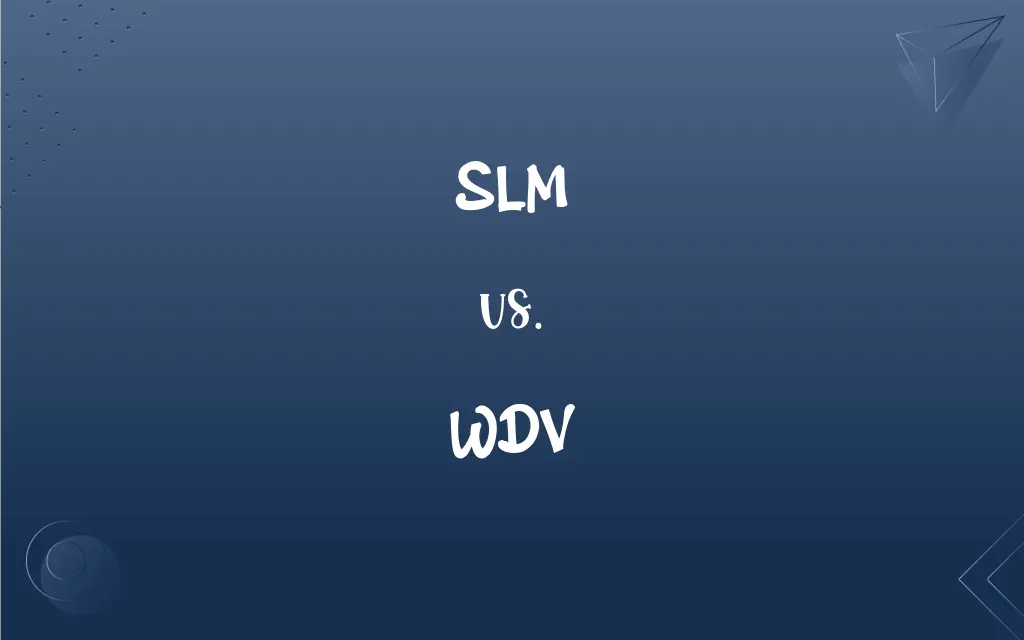SLM vs. WDV: What's the Difference?
Edited by Aimie Carlson || By Harlon Moss || Published on July 9, 2024
SLM (Straight Line Method) depreciates assets at a constant rate, while WDV (Written Down Value) applies reducing balance depreciation, faster in the initial years.

Key Differences
SLM (Straight Line Method) depreciates an asset equally over its useful life. WDV (Written Down Value), also known as declining balance method, depreciates assets more in the early years, reducing the value progressively.
SLM calculates depreciation on the original cost of the asset. In contrast, WDV calculates depreciation on the asset's remaining book value each year, leading to a decreasing depreciation expense.
SLM leads to a consistent depreciation expense each year. WDV results in higher depreciation charges in the early years and lower charges in later years.
SLM is suitable for assets with consistent utility over their life. WDV is preferred for assets that lose value quickly or have higher utility in the initial years.
The choice between SLM and WDV can affect tax deductions, as higher depreciation earlier (WDV) might offer tax advantages in some jurisdictions.
ADVERTISEMENT
Comparison Chart
Depreciation Rate
Fixed and equal annually.
Higher in initial years, decreasing thereafter.
Basis of Calculation
Original cost of the asset.
Book value of the asset at the start of each year.
Financial Statement Impact
Consistent expense each year.
Variable expense, higher in early years.
Asset Suitability
Assets with uniform utility over time.
Assets with higher early utility or rapid value loss.
Tax Considerations
Steady tax deductions.
Potential for higher initial tax deductions.
ADVERTISEMENT
SLM and WDV Definitions
SLM
Leads to a consistent charge on the profit and loss statement.
Using SLM ensured a uniform effect on the annual financial statements.
WDV
A depreciation method where the expense decreases over time.
The WDV method was used to depreciate the new computer system, recognizing its rapid value loss.
SLM
A depreciation method allocating an asset's cost evenly over its lifespan.
The company used SLM to depreciate its office furniture over ten years.
WDV
Calculates depreciation on the asset's remaining book value each year.
Their delivery vehicles, depreciated via WDV, had a decreasing charge each year.
SLM
Reflects a constant annual depreciation expense.
SLM resulted in a fixed annual depreciation of $5,000 for their machinery.
WDV
Often results in higher tax deductions in the initial years.
They opted for WDV to maximize tax benefits in the early years of asset acquisition.
SLM
Suitable for assets with a consistent performance and utility.
SLM was chosen for depreciating the building due to its long and stable utility.
WDV
Suitable for assets with high initial utility that decreases over time.
WDV was ideal for their manufacturing equipment due to its early high usage.
SLM
Simple to calculate and understand.
They preferred SLM for its straightforward calculation method.
WDV
Complex in calculation compared to SLM.
The accounting team used specialized software for the complex WDV calculations.
FAQs
How does SLM impact financial statements?
SLM results in a consistent depreciation expense each year on financial statements.
Why choose WDV over SLM?
WDV is chosen for assets that lose value quickly, offering higher initial depreciation.
What does SLM stand for?
SLM stands for Straight Line Method in depreciation accounting.
Does WDV lead to variable depreciation charges?
Yes, WDV leads to higher depreciation charges initially, decreasing over time.
What is the WDV method?
WDV, or Written Down Value, is a depreciation method with decreasing annual expenses.
Does WDV affect early-year profits?
Yes, WDV can lower early-year profits due to higher depreciation expenses.
What types of assets are suitable for SLM?
Assets with consistent performance and utility over their life are suitable for SLM.
Is SLM easy to calculate?
Yes, SLM is straightforward and easy to calculate.
Is SLM suitable for vehicles?
SLM can be used for vehicles, but WDV might be more suitable due to quicker value loss.
Can WDV offer tax advantages?
Yes, WDV can offer early tax advantages due to higher initial depreciation.
Is SLM depreciation based on the asset's original cost?
Yes, SLM depreciation is calculated based on the asset's original cost.
Is WDV more complex in accounting?
Yes, WDV is more complex due to its changing annual calculations.
How does WDV calculate depreciation?
WDV calculates depreciation on the book value of the asset at the start of each year.
Can SLM be used for technology equipment?
It can be used, but WDV might better reflect the rapid obsolescence of technology.
Can SLM be changed to WDV later?
Switching methods is generally not recommended as it complicates financial reporting.
What is the main benefit of using SLM?
The main benefit of SLM is its simplicity and consistent financial reporting.
Are there tax implications in choosing SLM?
Yes, SLM leads to steady tax deductions over the asset's life.
What's the impact of WDV on long-term asset value?
WDV results in a lower book value of the asset over time compared to SLM.
How does WDV handle high initial utility assets?
WDV handles these assets by allocating more depreciation in the early years of use.
How does the choice of method impact budgeting?
SLM provides predictable budgeting, while WDV might require more complex financial planning.
About Author
Written by
Harlon MossHarlon is a seasoned quality moderator and accomplished content writer for Difference Wiki. An alumnus of the prestigious University of California, he earned his degree in Computer Science. Leveraging his academic background, Harlon brings a meticulous and informed perspective to his work, ensuring content accuracy and excellence.
Edited by
Aimie CarlsonAimie Carlson, holding a master's degree in English literature, is a fervent English language enthusiast. She lends her writing talents to Difference Wiki, a prominent website that specializes in comparisons, offering readers insightful analyses that both captivate and inform.






































































